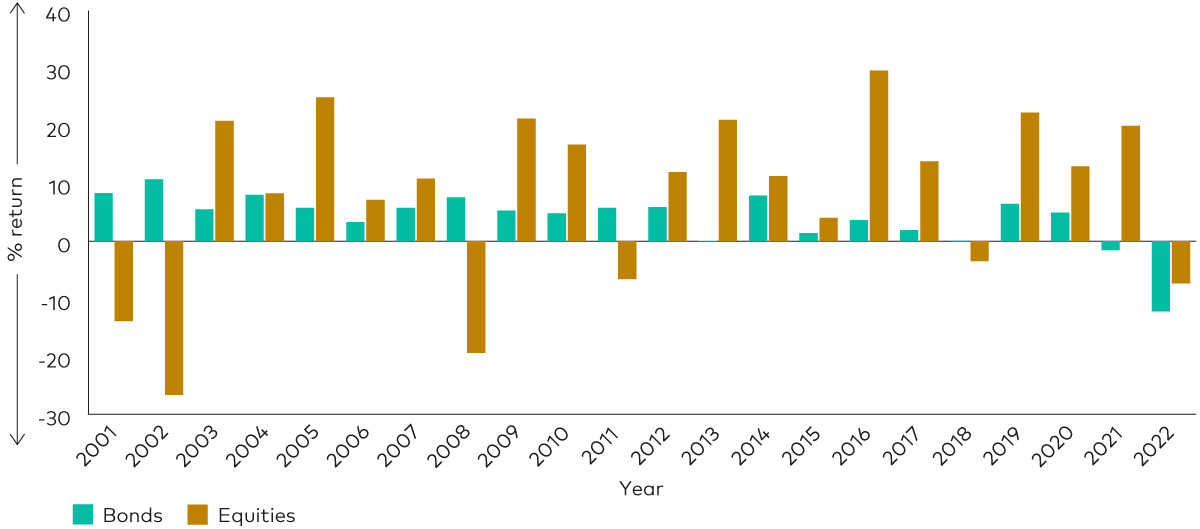It’s very easy, and very tempting, to focus on the markets, the economy, manager ratings or the performance of individual funds. This may lead you to overlook the basic principles that we believe give your clients the best chance of success.
Goals
Common mistakes that investors make include buying funds with good recent performance in the hope that it will continue, or trying to time market movements by buying and selling at exactly the right time. Our research shows that both efforts are incredibly difficult to get right, even for professional investors.
Help your client avoid these mistakes by following an investment strategy aligned to clear goals that are based on each client’s objectives, time horizon, risk profile and amount of investable assets, and stick with this plan regardless of the vagaries of the markets.
Clear, appropriate investment goals should be both measurable and attainable. Keeping the plan on track means evaluating progress and reporting to clients on a regular basis, typically at least annually.
Balance
A suitable asset allocation using broadly diversified funds is key to achieving each client’s goals. You can’t control what happens in the markets, but understanding the historical patterns of equities and bonds can help advisers select the right balance of investments for each client, thereby managing risk in portfolios.
The graph below shows the risk/return trade-off for global equities and bonds over the past 22 years. As you would expect, equities have typically posted higher returns but been prone to greater volatility.
The performance of different investments from 2001 - 2022

Past performance is not a reliable indicator of future returns.
The performance of an index is not the exact representation of any particular investment. As you cannot invest directly into an index, the performance shown in this table does not include the costs of investing in the relevant index. Basis of performance NAV to NAV with gross income reinvested. Sources: Bloomberg. Data period from 29 December 2000 to 31 December 2022. Indices used: Bonds: Bloomberg Global Aggregate Total Return, hedged in pounds sterling. Equities: FTSE All-World Total Return, in pounds sterling.
Clients with longer investment timeframes may be comfortable taking on more investment risk and allocating more of their portfolio to riskier assets such as equities. Those with shorter-term objectives will typically have a higher allocation to lower-risk assets like bonds.
Cost
Understanding the impact of costs on long-term returns is a key step towards investment success. Investment costs are within your control; the direction of financial markets is not.
Minimising expenses by focusing on lower-cost investment solutions increases the chance of outperformance. The graph below illustrates the potential impact of costs on an investment of £10,000 over a 30-year period. Assuming a compound annual growth rate of 6%, fund expenses of 0.3% would save a client £11,943 relative to expenses of 1.2%.
Growth of a £10,000 investment over a 30-year period, assuming 6% growth per annum

This hypothetical example assumes an investment of £10,000 over 30 years. Annual compounding is used for both the assumption of 6% average growth per annum and the investment costs. Costs are applied to average annual growth of 6% for each year. As it is hypothetical, this example does not represent any particular investment.
Source: Vanguard.
Discipline
While a suitable asset allocation is key to achieving a client’s objectives, the strategy only works if they stick to it over time, regardless of market uncertainty.
Instilling in clients the importance of discipline and perspective can help them to remain committed to their long-term investment strategy through market ups and downs.
Rebalancing is important, too. Returning a portfolio to its original asset allocation helps to ensure it remains in line with a client’s objectives and attitude to risk.
Key takeaways
Focus on what you can control for investment success.
Clear, appropriate investment goals should be both measurable and attainable.
Manage the risk/return trade-off by building low-cost portfolios of broadly diversified funds.
Long-term discipline can help clients to navigate the ups and downs of financial markets.
To read more about diversification, see ‘The power of portfolio diversification’.

If you have completed all content in the module, you are ready to take the quiz and collect your CPD
Ready to test your knowledge?
Take the quizOther Vanguard 365 pillars
Client relationships
CPD content crafted to empower you to service your client’s needs effectively, build relationships, create loyalty and achieve new business growth.
Practice management
CPD content designed to help you build your practice, market your services effectively and cultivate a thriving professional network.
Financial planning
CPD content structured to give you access to useful tools, guides and multimedia resources covering diverse topics from risk profiling to retirement planning.
Investment risk information
The value of investments, and the income from them, may fall or rise and investors may get back less than they invested.
Important information
This article is designed for use by, and is directed only at persons resident in the UK.
The information contained in this article is not to be regarded as an offer to buy or sell or the solicitation of any offer to buy or sell securities in any jurisdiction where such an offer or solicitation is against the law, or to anyone to whom it is unlawful to make such an offer or solicitation, or if the person making the offer or solicitation is not qualified to do so. The information in this document does not constitute legal, tax, or investment advice. You must not, therefore, rely on the content of this article when making any investment decisions.
The information contained in this article is for educational purposes only and is not a recommendation or solicitation to buy or sell investments.